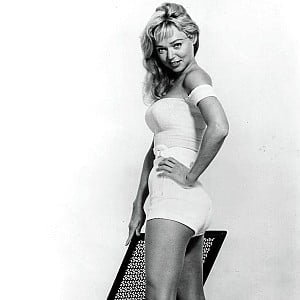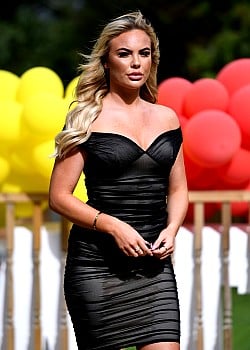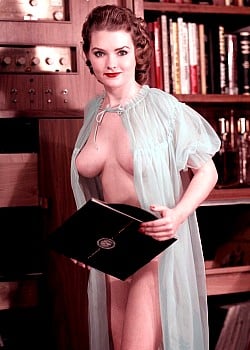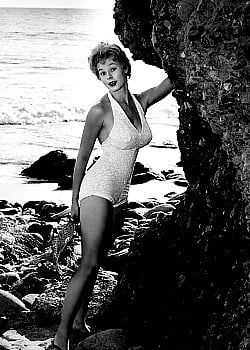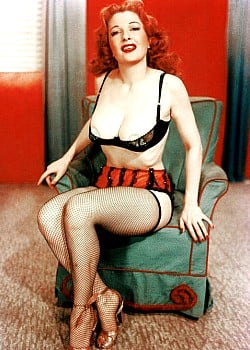Yvette Vickers
and email-confirmed if you want to vote.
- Died: Wednesday 27th of April 2011 (age 82)
- Born: Sunday 26th of August 1928
- Birthplace: Kansas City, Missouri, United States
- Ethnicity: Caucasian
- Sexuality: Straight
- Profession: Adult Model (former), Centerfold (former), Playboy Model (former)
- Hair color: Blonde
- Eye color: Brown
- Height: 5'3" (or 160 cm) (Petite)
- Weight: 106 lbs (or 48 kg)
- Body type: Slim
- Measurements: 36-24-36
- Bra/cup size: 34C show conversions - UK: 34C, EU: 75C, AU: 12C, JP: 75C (cup size number shows band size measurement)
- Boobs: Real/Natural
- Pubic hair: Bush/Natural
- Achievements:
- Playboy Playmate Of The Month July 1959
About Yvette Vickers
Her mummified remains were found in her home approximately 8 months after her death by a neighbor.
The following was printed in Los Angeles Magazine athttps://www.lamag.com/longform/left-behind1/
Left Behind
As an actress, she never rose out of B-grade obscurity, but whe n her mummified corpse was found last year, Yvette Vickers drew the international headlines she’d always yearned for
By Steven Mikulan -February 1, 2012
Share
A blast of heatslapped the side of Susan Savage’s face as she stood at the top of the stairs inside her neighbor’s Benedict Canyon cottage. It was a spring afternoon in 2011, and a growing dread had made Savage a little woozy as she crawled into the barricaded home belonging to Yvette Vickers, an 82-year-old B-movie actress who lived a few doors away. Savage hadn’t been on good terms with Vickers for years—not since Savage pointed out that Vickers’s dog, Garbo, had gotten into the yard to play with her dog, Orson. But the neighborhood recluse’s mailbox had begun filling with yellowing envelopes, and Savage was here to check on her.
Westwanda Drive is the kind of tight, shaded road where drivers instinctively inhale when two cars pass each other. Musicians, senior UCLA faculty, and movie people live in hillside houses that seem in danger of being engulfed by the ivy and bougainvillea that creep up the vertiginous landscape. Since buying her home from Godfather II producer Fred Roos in the early ’90s, Savage had become the unofficial mayor of Westwanda. Trim and middle aged, with sand-colored hair, she sells specialty desserts to bakeries and runs a theater company, but Savage’s main focus is acting; she’d just booked a commercial that day. Savage had heard all the stories about her colorful neighbor, who’d appeared in Attack of the 50 Ft. Woman: Vickers walking up the street in her nightgown, martini in hand; Vickers striking up romantic liaisons with some of Westwanda’s men; Vickers’s home as a favorite destination for trick-or-treaters on Halloween. “I’ve got a lot of sugar daddies in the desert,” she’d tell Savage. As she became more withered and eccentric, Vickers began complaining to neighbors and friends that she was being stalked. But stalkers—at Vickers’s age and with her level of obscurity? People were skeptical.
Savage had tried persuading a resident nearby to come with her to Vickers’s, but the man wasn’t interested. So she’d climbed the steep steps to the 676-square-foot cottage alone, past the neglected letter box and the new phone books that sat next to it, to the downstairs door, which was behind steel fencing. Mold-covered fan mail was scattered on the ground. By now Savage had begun to expect the worst. She eventually pushed in a loose window in the door that had been held in place with duct tape and peered inside. There on the floor lay a shock of blond hair. “I jumped like a cat,” she says, pantomiming the action in her living room. Once she realized the hair was only a wig, Savage reached down, undid two inside locks, and lifted up the two-by-four that stretched across the door. Then she was in.
The downstairs resembled something from an H.P. Lovecraft story: huge Rorschach patterns stained the walls and long ivy vines snaked through a house whose missing patches of wall were concealed with blue tarpaulin. The place was a hoarder’s lair, crammed with trash and empty bottles of Harveys Bristol Cream, along with jugs of Woodbridge chardonnay. Covered in cobwebs, her shin bleeding from a rebar cut, Savage called out her neighbor’s name—“Yvette! Yvette?”—but knew there wouldn’t be a reply. A staircase leading upstairs was closed off by a locked door and braced on the other side by boxes and debris. Savage discovered a tarped-over gap in the drywall and crawled through. When she emerged at the top of the stairs, the burst of hot air hit her. It was coming from a heater that whirred in the next room, a disheveled space where Vickers had set up a hot plate and a refrigerator. Savage batted away crumpled papers that were close to the heater before turning it off.
Looking down, she noticed a phone receiver off the hook and, nearby, clothes that lay along the floor in front of a daybed. She bent down to inspect the pile. At one end of some leathery substance was a spray of black spores; at the other, sprouting from a mass of what looked like red jerky, were tufts of scraggly hair. The true meaning of the pile came into sickening focus, and Savage ran from the house screaming—the hair did not belong to a wig.
The police and coroner’s staff who soon arrived found Vickers’s body in a state of “severe advanced decomposition/mummification,” as the medical examiner’s report noted. At first the deputy medical examiner could only guess Vickers’s sex and surmise that she had been dead several months. Though no organs were still present in her desiccated body, calcified tissue in the area where the heart would have been suggested that she had died of cardiovascular disease. The 56 pounds of remains were driven to the county morgue and placed in Crypt 614 to await release to her next of kin. In the months leading to the macabre discovery of Vickers’s body, no calls had been placed to police from concerned relatives or neighbors.
Hollywood beauties have been dying young since movies began—long before Marilyn Monroe or Peg Entwistle, the 24-year-old who in 1932 jumped off the letter H of the Hollywood sign in a moment of career despondency. In an industry where crash-and-burn cycles are a given, nothing whets our Hollywood Babylon schadenfreude more than the self-destruction of a gorgeous actress. Yvette Vickers’s story, though, is different. Vickers was a slow-motion tragedy that took decades to reach its ghoulish climax, long after she’d given up on the hard work she’d done to make it in the Industry. In the end she turned her back on the world and holed up in her cottage, subsisting on the adulation of fans who would never guess their letters to her were gathering mold.
Vickers’s first newspaper mention described her in 1949 as “reminiscent of Jean Harlow as a dazzler.” It was a Los Angeles Times squib about how she would be joining Nancy Olson, a fellow theater major at UCLA, in the cast of Sunset Boulevard. Olson was William Holden and Gloria Swanson’s costar; Vickers would be an uncredited walk-on—that’s her handing a phone to Holden in the party scene. The Billy Wilder film must have seemed an auspicious way to enter Hollywood for an ingenue in college.
She’d learned early on the challenges of being a struggling artist. Her parents, Chuck and Iola Maria Vedder, were itinerant jazz musicians who moved from Kansas City to California in 1936, when Yvette was eight. Chuck blew tenor sax, and Iola played piano, usually in a trio, their only child singing with them from time to time in clubs from Oxnard to Santa Barbara. The family eventually moved to Ramirez Canyon in Malibu before Yvette entered UCLA in the fall of 1947.
Following her film debut, she changed her name to Vickers and studied briefly in New York, returning to L.A. to fulfill her promise. She performed as a dancer on TV variety shows. She was the White Rain Shampoo girl. She even scored minor roles in low-budget movies and on TV series like Dragnet and Bat Masterson, and she belonged to L.A.’s small-theater scene. One day in 1953, Vickers was dancing in a string of USO shows in Orange County. On the bus shuttling the entertainers between military bases, she began talking to the man who would become her husband, Don Prell, a jazz bassist. “When I first met her, we got it on in the sand at Huntington Beach,” recalls Prell, who is 82 but speaks with the enthusiasm of a much younger man. He lives in San Francisco, where he spent 35 years with that city’s symphony. “We met and got rolling,” he says of Vickers. “She said she wanted me to meet her parents, and so we drive to her parents’ house at the top of a hill in Malibu. Her father knew Charlie Parker, who was my hero, and he’d visited him when he was in Camarillo. Her father was working at a little joint in Oxnard.”
Prell and Vickers soon married in Tijuana. After driving back the same day from Baja, the newlyweds attended a party thrown by Vickers’s friends in Los Angeles. Prell found the gathering a little too wild for his taste. “I was a hick jazz musician,” he says. “I didn’t know about guys that were like ladies. It was overboard.” He would leave the party alone and spend his wedding night at his parents’ home.
They moved into the house Prell had bought on Westwanda Drive, an elfin two-gabled cottage built into a steep hillside; Prell spent hours painting the ceilings different colors. To help speed their careers, the pair opted against having children. But the marriage was short-lived. She worked days. He worked nights, when his wife would often go out to party. Prell would return from gigs at two or three in the morning to an empty home, though at the time he took their distance from each other in stride. “When you’re with somebody who’s pretty slick looking, you don’t think about it,” he says. “I thought that’s how Hollywood ran—that you hardly talk to each other. She was probably getting chased around a couch someplace.” One night Prell came back from a cross-country road trip with the Bud Shank Quartet to find a note from Vickers informing him that she’d left him. “She said I was ruining her career,” he recalls. “We had some really good stuff together. It wasn’t like we were walking around holding hands saying this is paradise. But being an actress really puts a crimp in things—you can’t play that casting couch thing to get jobs if you’re married.”
////
A Los Angeles Examiner courthouse photo from 1957 shows a glamorous blond in a tightly cinched dress striding toward the camera. Yvette Vickers’s face under the Marilyn coif is almost doll-like, with a high forehead, downturned smile, and button nose. The actress looks determined but satisfied—she had just been granted a divorce from Prell and awarded the Westwanda property.
“I always thought her home was unique—like a cliff dweller’s,” says Robert Vedder, a younger first cousin who came out from Kansas City, Missouri, in 1958. “She had this refrigerator that had a red light inside, and every liquor bottle she bought she’d remove the label and stick it on the outside of the fridge.” Vedder was floored when actor Chuck Connors dropped by to give Vickers a dog she named Hi-Fi. Vedder’s famous cousin was family, but at the same time seemed to belong to another species of being.
A year after the divorce her agent talked her into taking a part in Attack of the 50 Ft. Woman, a down-market science-fiction fable in which a socialite, touched by a space alien, grows five stories tall and wanders the California countryside in her underwear. Down below, Vickers’s character, Honey Parker, is having an affair with the big woman’s human-size husband. It was a film denuded of logic or believable dialogue, yet Vickers showed she could act: Her scenes with costar William Hudson display a skilled balance between vampy comedy and indolent eroticism.
She followed that a year later with Attack of the Giant Leeches, an even cheesier film in which Vickers acquired a Southern accent and skin-tight wardrobe. In one striptease-like scene she drops a too-small kimono to reveal leopard-print underwear as a clarinet moans in the background. Leeches oozed the kind of backseat sexuality that would be seared into the memories of those who watched the film as it was shown in rotation on after-school television in the 1960s.
“[W]hen I lay in bed at night under my eave,” Stephen King has written, “listening to the wind in the trees or the rats in the attic, it was not Debbie Reynolds as Tammy or Sandra Dee as Gidget that I dreamed of, but Yvette Vickers from Attack of the Giant Leeches.”
Vickers exuded an almost adolescent seductiveness that A-list movies were not ready for in the 1950s. Whereas classic studio beauties like Gene Tierney and Rita Hayworth could cast refined come-hither glances, the Vickers look shouted “Come and get it!” By 1959, Vickers doubled down on her status as a sex symbol by posing in Playboy for Russ Meyer, who was then a photographer. It was a brave move—or a desperate one—in the twilight of the Eisenhower era. Marilyn Monroe and Jayne Mansfield had famously appeared in the magazine, but Monroe’s nude photo had been taken years before she’d become a star, and Mansfield’s career never really rose above that of a media oddity anyway. “We used a ‘beat’ theme,” Hugh Hefner remembers of Vickers’s spread. “We called her our ‘Beat Playmate.’ ” The July 1959 issue featured shots of Vickers strolling outside coffeehouses, reading beside an old-fashioned wick lamp, and intently listening to jazz in Hollywood’s Cosmo Alley. Then her clothes came off.
“I got a call from our lawyer who had concerns that the image was too explicit,” Playboy’s founder says of Vickers’s centerfold, which featured her lying prone on a couch with her derriere exposed. “Her bum was raised, and he thought it was an invitation to sodomy. I said, ‘You’ve got a naughty mind.’ ”
Prell remembers the image well. “At the time I was playing with the San Francisco Symphony—a very legit gig,” he says. “One night I go into the carpenter’s room and see my ex-wife’s naked picture up on the wall. Someone had stuck a rose into her butt. I’m thinking, Hey, man, that’s my ex-wife!”
////
Seen from a distance, Yvette Vickers looked as though she could have been anything in Hollywood. A Lana Turner-ish five feet three, she radiated the vulnerable charm of a young Ida Lupino, who’d broken through as Humphrey Bogart’s costar in the early noir High Sierra. But an adamant determination also lay behind the beauty. Vickers had been dancing since childhood, and she knew how to hit her marks onstage in live theater. Most important, she devoted herself to her career. “It was never about money,” Prell says. “She would have stuck with dancing if that had been the case. She had a desire to act, the same way I had a desire to play music.”
Vickers had the face and the poise; she did the preparation and the work. In Short Cut to Hell she would prove she had the ability, too. The 1957 Paramount project was a remake of This Gun for Hire, the film noir that had made a star of Alan Ladd 15 years before; it marked James Cagney’s directorial debut and Vickers’s first big role: She was Daisy, the second female lead. “Jimmy Cagney and I needed a sultry young lady, and she did that very well,” says veteran producer A.C. Lyles, who at 93 still maintains an office at Paramount. Lyles produced the film, which bombed without Vickers getting any buzz for her performance. And that became the story of her life—perhaps more hurtful than any critical jeers, all she heard was silence. “She was very talented,” remembers veteran character actor Tom Troupe, who performed onstage in Hollywood with Vickers at the gore-themed Grand Guignol Theater on Vine Street. “I thought she was going to be a big star. Her name was known to people.”
Yet it would be Vickers’s fellow theater company members, such as Beverly Garland and Carolyn Jones, who went on to midlevel fame while she stayed behind. Los Angeles Times theater reviews of the shows she was involved in from the 1950s and early ’60s mostly mention Vickers only in passing; when they do add a word or two of description, the critics seem to be straining for things to say about her performances. It’s true that although she didn’t have a studio’s PR machine behind her, she was considered sexy enough to be interviewed for national syndication, to pop up favorably in gossip columns, and to be asked for tips on hairstyling. None of it made her a star.
By the time Vickers appeared in Playboy in 1959, she had remarried and quickly separated. Vickers would later tell a judge that her husband, Leonard Burns, “ended all our arguments with the statement, ‘You are not worthy of me.’ ” As the 1950s ended she landed on Broadway in The Gang’s All Here, a Jerome Lawrence and Robert E. Lee drama about a doomed Warren Harding-esque president. Vickers appeared prominently in caricaturist Al Hirschfeld’s New York Times illustration for the show, though her part was small. She played Laverne, a Roaring Twenties flapper/escort, who’s described as “giggling” before she enters the stage. Indeed, Lyles remembers Vickers the same way off the stage. “She was very sweet,” he says. “She giggled a lot.” Maybe that was it—she was typecast as a giggling tart and wasn’t taken seriously for A-list movies. There must have come a moment when she wondered if there was anything she could have done to make it in the entertainment industry. What, after all, determines who snatches the brass ring of recognition, or even notoriety?
“If I could answer that, I would be the richest man in Hollywood,” says Lyles. “We kept in touch for some time afterward. Once she called me and said she’d gotten an apartment on Sunset Boulevard near Columbia Pictures. She said, ‘I would only have to walk five minutes to get to work if I got cast in something.’ I lost touch with her because she seemed to disappear. It happens a lot in our business.”
As Vickers’s obituaries piled on last year, her old sex kitten photos were exhumed from photo morgues: Yvette fully clothed and soaking in a swimming pool, her winter blue eyes peering out from a wet tangle of auburn hair; Yvette straddling a log, dressed in a kimono that seemed unable to close; Yvette curled up on a chair, pulling strands of long hair across her mouth. Juxtaposed with her vintage pinups was more recent imagery showing a plump Vickers wearing wide-brimmed hats. The before-and-after images were predictable Hollywood Babylonia. The older Vickers, with her thick, almost rubbery features, seemed to have sprung from the lines of “Provide, Provide,” Robert Frost’s cautionary poem about the Hollywood beauty who becomes a “withered hag.”
“She didn’t get the right connections or whatever,” Prell says. “I was appalled to find that she’d died and no one knew about it. When I think of all the people who made it but never worked half as hard as Yvette…” Prell’s voice trails off, fading into a kind of verbal shrug.
////
It’s hard not to think of Vickers as an orphan adrift in Hollywood: Had she arrived only a few years earlier, she might have been put under contract and given greater opportunities. Ava Norring, a Hungarian-born actress and contemporary of Vickers, believes that Vickers’s career possibly suffered from her missing the protective (and at times smothering) embrace of the old studio system that had “discovered” Norring in a Look magazine photo and set her up in Hollywood. “Everything was easy for me,” Norring recalls. “The studio took care of everything—they found me a place to live and took me where I wanted to go. I never had to do anything.” But during the few years Norring left for New York to spend time raising her children, that system vanished. When Norring, who had made only three pictures, tried to work again, she found the door was closed to her.
Today she resides at the Motion Picture and Television Fund’s retirement home for actors and other Hollywood professionals. Norring has a pleasant room with a patio overlooking rolling lawns. It’s part of a serene, leafy campus of 44 acres in Woodland Hills that has been serving elderly and infirm members of the Industry since about the time Vickers first handed that phone to William Holden. But the only reason the hospital is standing is because of a bitter no-prisoners war that former MPTF administrators fought with the residents and their family members, who resisted a 2009 decision to close the hospital in the face of rising health care costs. Nothing comes easy in Hollywood, especially for actors after their careers end. Some, like Norring and Vickers’s 50 Ft. Woman costar, William Hudson, who died in the 1970s, are able to spend their last years at the MPTF home; others fend for themselves in old age.
Vickers’s Benedict Canyon aerie was, in a way, a tribute to independent living, a place where a legally blind octogenarian lived on her own terms. And like Vickers’s career, the Westwanda property appeared as something to be envied. The grounds’ insurgent bougainvillea and ivy seemed to personify a life of bohemian artistry. Of course, in hindsight that bougainvillea and ivy turned out to be shielding a disordered existence, a brutal vision of retirement turned inside out.
After The Gang’s All Here folded in 1960, Vickers worked only sporadically in movies and on TV. Fantasy-film historian Tom Weaver, who interviewed Vickers for a chapter in his book Science Fiction Stars and Horror Heroes, recalls her describing the nosedive her career took: “It all started when I did a director friend a favor by taking a part in Pressure Point. After that I got to be known as ‘the bit-part actress.’ Miss Bit Part 1963.” In that film, an earnest throat clearer from producer Stanley Kramer, American Nazi Bobby Darin is cured of his violent self-loathing by Freudian shrink Sidney Poitier. An uncredited Vickers appears as a carefree drunk who has no lines but giggles a lot—especially when a philandering husband tosses her onto his wife’s bed.
A professional abyss was widening at her feet when, in 1962, Vickers was cast in the Paul Newman classic, Hud. As the unfaithful wife Lily Peters, she made it onscreen for a single scene in which she is introduced to Hud Bannon’s disapproving father, played by Melvyn Douglas. Vickers would claim later that her other scenes had been cut because of their sexual steaminess. Though a long early screenplay does feature Lily much more, it’s likely that the need for a streamlined telling of Larry McMurtry’s novel Horseman, Pass By made the cuts necessary.
Vickers’s opportunities were shrinking, and she had no Plan B, not that actresses of that time had many fallbacks besides marriage. “If you were an actress back then and putting everything into that and it wasn’t working out, it was much harder to segue into another kind of professional life,” notes Leah Kalish, a former actress and dancer 28 years Vickers’s junior. She quit Hollywood in the late 1990s to set up an educational media business that teaches yoga in schools.
“Don’t make yourself an open book,” Vickers once told Los Angeles Times columnist Lydia Lane in the early ’60s. “Because an air of mystery is always intriguing.” The interview was titled “How to Be Popular.” Mostly, though, Vickers’s appearances in the news were in supporting roles in gossip columns—for dating actors Ralph Meeker and Jim Hutton (Timothy Hutton’s father), with whom she carried on a years-long affair until Hutton’s death. She was also rumored to have been involved with Lee Marvin and would tell friends she’d had an affair with Cary Grant. “She kind of became the girlfriend of famous people,” says Robert Vedder’s son, Christian, who describes himself as the family historian.
After Hud, Vickers would act in only three more films and on a smattering of TV shows, some of them in uncredited roles. She’d been fibbing about how old she was since the end of the 1950s, but now she had reached her late thirties, when actresses find themselves being aged out of the job market. She was too sexy to play anyone’s mother, too old to be a vixen. Perhaps without her realizing it, the career to which she’d devoted herself was over. She tried her hand at real estate while caring for her ailing parents, who had moved to the High Desert, and she cut a jazz CD in tribute to them. Then her eyes became ravaged by macular degeneration.
Just when she seemed dead to the public, however, Vickers underwent a curious resurrection—the era of the fan convention had arrived. All those boys who’d watched her on TV in the 1960s had grown up. They brought with them revisionist views of low-budget films and anointed nearly every movie that had been part of a drive-in bill a “cult classic.” Like “horror queens” Ingrid Pitt and Barbara Steele, Yvette Vickers became part of a circuit of lowbrow film festivals, panel discussions, and autograph signings—not only for horror fans but for western movie buffs and B-film aficionados. “These places pay all your expenses, meals, and maybe throw in a few dollars,” Weaver says. “You can make some money autographing pictures for $20 apiece.” Su
Yvette Vickers Performances
Solo: Nudity (Topless Only)
Yvette Vickers Links
| Site Logo | Link | Publication Date | Report Link |
|---|---|---|---|
| Playmate of the Month July 1959 - Yvette Vickers - Playboy Plus | 2022-12-08 | ⚠ | |
| Yvette Vickers - Boobpedia - Encyclopedia of big boobs | 2022-10-25 | ⚠ | |
| Yvette Vickers nude from Playboy Plus at theNude.com | 2019-12-29 | ⚠ |
Leave a comment
Commenting is disabled for non-registered users. Please register and login if you want to leave comments.












